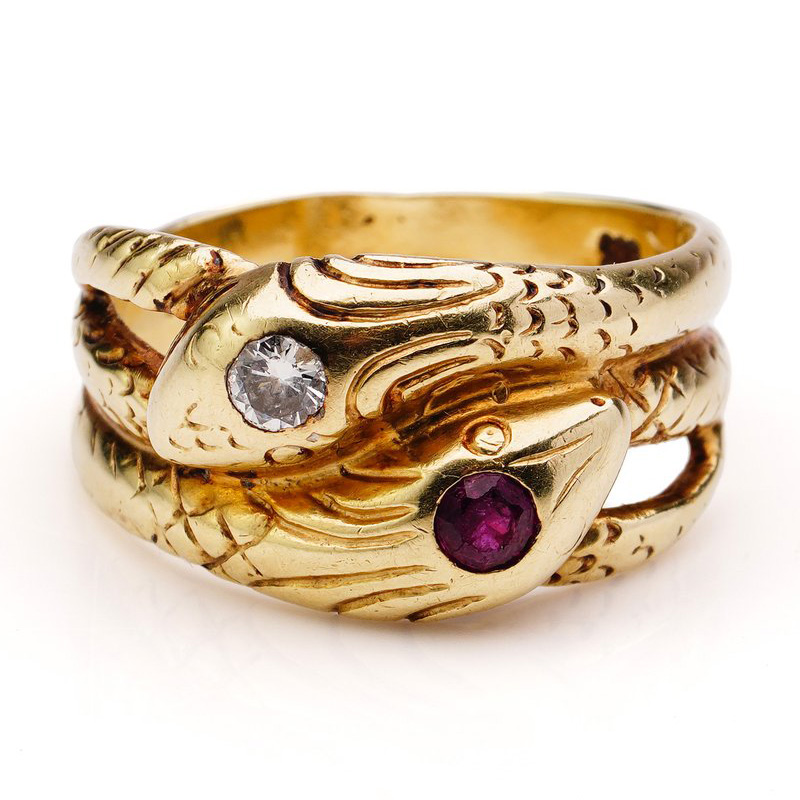Antique snake Necklaces
In the Victorian period very popular snake necklaces, this example has been set with Garnets and diamonds on an 18ct gold coiled chain
The snake has lots of history of symbolism which dates back thousands of years and many cultures have used the snake to represent various things including good, evil, rebirth, poison, fertility and death.
Although there are plenty of negative connotations, there are also many positives, too.
Ancient Egyptians used snakes as a symbol or royalty or deity, whilst in Hinduism, it represents sexual passion and desire.
In ancient Chinese mythology, the snake is closely related to the Gods and that it could prolong your life, seen as a symbol of reproduction and good luck.
In Roman mythology, the snake is believed to represent everlasting love.
Victorian Snake Jewellery Meaning
Queen Victoria took her beliefs from when Prince Albert proposed to her with a continuous snake ring, set with her birth stone which was an emerald for May.
She then announced the snake as a symbol of eternal love.
After the proposal, snake jewellery became very popular through out the Victorian era. In 1840’s the snake is seen to represent eternity and wisdom.
Rings, bracelets, necklaces, brooches and pendants all had snake designs.
Asclepius the Greek god of medicine held a rod that bore one snake. This snake winds around a Rod of Asclepius asymmetrically, and there are no wings.
Caduceus is a symbol with a short staff entwined by two serpents, sometimes surmounted by wings

The Victorian snake rings were made and designed in a number of different styles.
The bodies of the snake were made up of one, two or three gold bands
Most snakes of the victorian period had gemstones set to the head or eyes these were normally diamond or rubies.
The finest and well made snake rings are more defined and detailed heads.

The serpent or snake necklace are designed to show a serpent coiled around the neck.
There are a few different styles, from the Victorian snake necklaces with typically have a gold coiled chain necklace with a centre piece snake head decorated with either blue enamel, diamonds, turquoise, garnets, pearls or other gemstones.
The most collectable snake necklace are the ones with rich blue enamel snake necklaces with diamond encrusted heads.
The vintage style snake necklace are more flexible gold links, some have been set with more diamonds heads, turquoise is not used as much and have a crossover snake head most of these date from 1960’s to 1980’s sometimes with Italian marks on in 9ct gold.
In the Victorian period very popular snake necklaces, this example has been set with Garnets and diamonds on an 18ct gold coiled chain
A Vintage Italian 18ct gold snake necklace with a slider as a clasp. Circa 1970’s
This wonderful example snake necklace has been set with a rich blue enamel and large old mine cut diamonds in its original box dating from 1860. the body coil is mounted in 18ct gold

Snake bracelets that were popular in the victorian period include gold coiled bangles which could have 1,3 or many coil wraps which would be worn either at the bottom or top of the arm. Gold woven wirework gold bangles, and enamel bangles were also popular styles. All of which included decorative snake heads set with diamonds, turquoise and garnet being the top choices.
The finest and most collectable snake bracelets or bangles have a royal blue enamel head encrusted with diamonds, pearls or gemstones with ruby or diamond set eyes. Usually a heart shaped pendant containing a lock of hair suspended from the reptile’s mouth.
This stunning snake bangle dates from 1840 when the snake jewellery was very popular
An Antique gold coiled snake bracelet, the head is set with an oval, old-cut diamonds. English Circa 1870
A antique gold bangle with a snake head set with a cabochon cut garnet circa 1880 English
In the Mid 20th Century snake jewellery started making a come back by the famous jewellery houses using this theme.
Cartier made a snake necklace in 1968 for the Mexican actress mounted in platinum with 2,473 diamonds. The underside is enamelled in red, green and black, so the piece can be worn in two ways as it’s completely reversible.

The Jewellery House of Bulgari began producing snake-inspired bracelets in the late 1940s to the present day. The snake become a symbol for their brand.
In the 1960s, a variety of style Serpenti watches were introduced in yellow gold, white gold or a combination, and various enamel examples were also offered, many with diamond and other gemstone accents which were one of there most popular and desired ladies watches.
Also during this era, a specially made Serpenti adorned the wrist of on the set of “Cleopatra,” further drawing attention to this icon-in-the-making and no doubt enhancing its already-wide appeal. They also created one-of-a-kind bracelets for celebrities such as Elizabeth Taylor as shown below which made the demand even higher.
Bulgari Serpenti Watch, two colour gold
A expectational diamond encrusted Bulgari snake necklace dating from
Elizabeth Taylor’s Bulgari Serpent Bracelet.